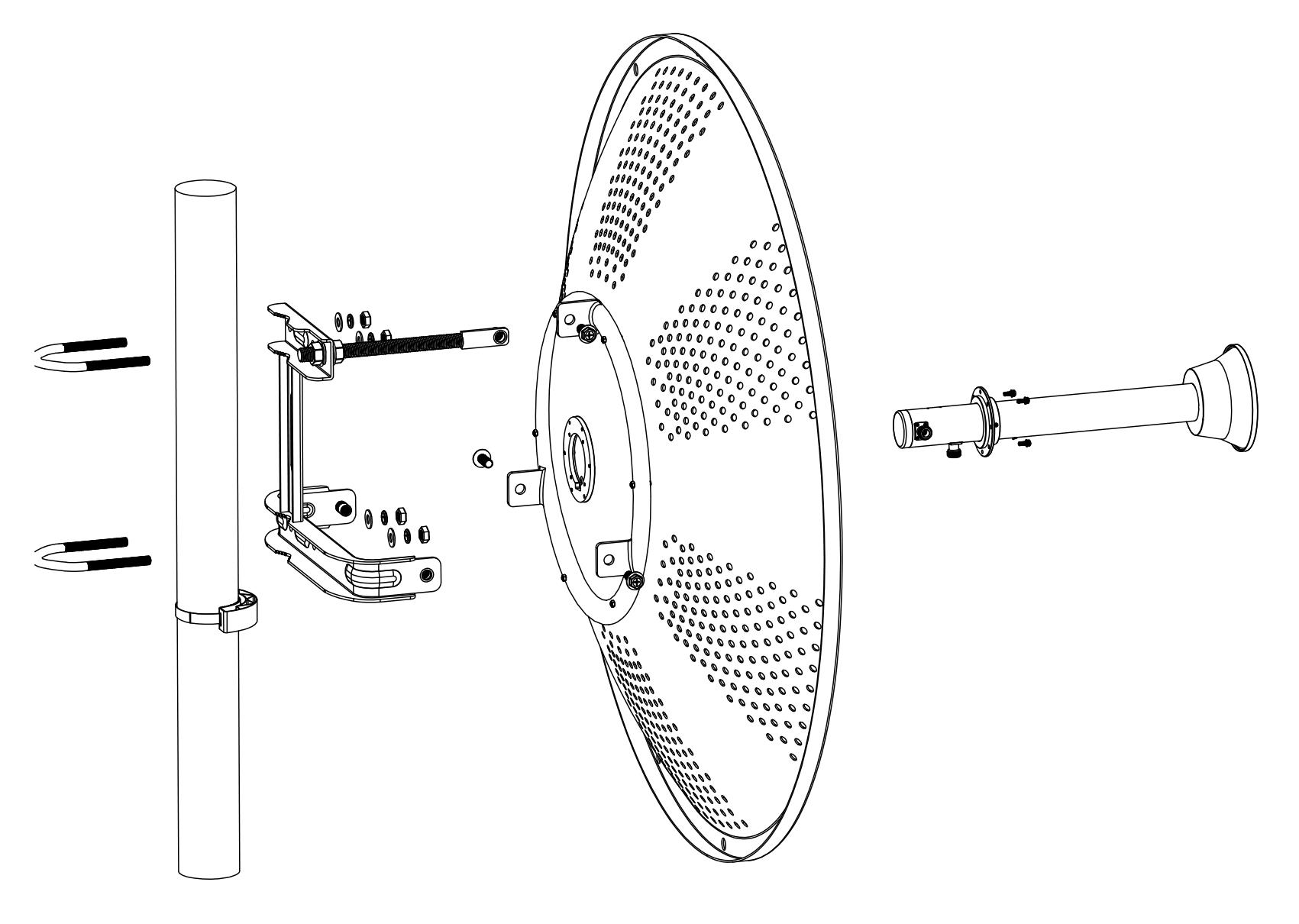Freq.: 4900-6400 MHz
Gain: 32 dBi
VSWR: ≤1.8
HPBWH: 3.5°
HPBWV: 3.5°
Polarization: Horizontal+Vertical
.png)
The model XJS-DP-D4964-32HV is a popular MIMO parabolic antenna of XJS technology. It has the characteristics of high gain(32dBi) and high front to back ratio. It can maintain high performance in the frequency range of 4900-6400MHz and is suitable for outdoor remote point-to-point(PTP) 5GHz WiFi signal transmission to solve the problem of remote signal reception or transmission. XJS technology uses 2.0mm thick paraboloid, sufficient material, make the antenna durable.
This antenna uses pure copper N-Female connector and is equipped with two low-loss RG141 jumper cables to reduce signal transmission loss and ensure high performance of the antenna.
In terms of installation details, XJS technology has made more humanistic consideration for parts, making installation faster and more convenient, and improving users' experience of use.
Over the years, with good antenna quality and professional service, XJS Technology has been favored by customers.
●Mounting Bracket x 1 ●Feeder x 1 ●Jumper Cable x 2 ●φ90cm Dish x1
.jpg)
The pure cooper N--Female connectors: less signal loss, stronger signal
.png)
The newly upgraded mounting bracket: firm and durable,more convenient installation
.png)
.png)
Upgrade version
1.intergrally-formed
2.sturdy and durable
3.with strengthening rib
.png)
Upgrade version
Made with aluminum and suS304 no rusted, easy install
Previous version iron with painting
.png)
Upgrade Version
jagged
anti-slip more stable
.png)
Upgrade Version: Intergrally-formed
.png)
Upgrade version:
Made with aluminum and suS304 no rusted, easy install
Previous version:
iron with painting
.png)

Absolutely Yes! The mimo dish antenna is a worthy investment, because it could help ondition the outdoor signal and get you better data rates.
Increased data throughput: MIMO technology allows for simultaneous transmission and reception of multiple data streams over the same frequency band. By utilizing multiple antennas at both the transmitter and receiver, MIMO can exploit the spatial dimension of the wireless channel to transmit more data concurrently. This results in increased data throughput and improved spectral efficiency, enabling higher data rates and better overall performance.
●Enhanced reliability and coverage: MIMO antennas can mitigate the effects of multipath fading, which is caused by signal reflections, scattering, and diffraction in wireless environments. By transmitting multiple spatially diverse streams, MIMO can effectively overcome signal degradation and improve the reliability of wireless communication. This leads to better coverage and reduced dead spots, especially in challenging environments such as urban areas or indoor spaces.
●Improved link quality and range: MIMO antennas can enhance the signal quality and extend the communication range. By leveraging the spatial diversity of multiple antennas, MIMO systems can combat signal attenuation and improve the received signal strength. This results in better link quality, reduced bit error rates, and increased range for wireless communication systems.
●Interference reduction: MIMO technology can mitigate the effects of co-channel interference. By using multiple antennas, MIMO systems can separate different signals spatially, allowing for simultaneous transmission and reception of multiple signals on the same frequency. This helps in reducing interference and improving overall system capacity.
●Diversity gain and reliability: MIMO antennas provide diversity gain, which is the improvement in signal quality obtained through spatially separated antennas. By receiving multiple copies of the same signal via different paths, MIMO can combine these signals to improve the overall reliability of the wireless link. This makes MIMO particularly effective in mitigating the impact of fading and improving the system's resilience to signal variations.
●Flexibility and adaptability: MIMO antennas offer flexibility in adapting to different channel conditions. They can adaptively adjust the transmission scheme, such as the number of spatial streams or antenna weights, based on channel state information. This adaptability allows MIMO systems to optimize performance and adapt to varying environments, thereby increasing overall efficiency and capacity.
It depends on your specific requirements and use case. There isn't a one-size-fits-all answer to this question, as the best antenna for you will depend on factors like the frequency range you need, the distance you want to cover, the environment in which the antenna will be used, and your budget. This 32 dbi mimo dish antenna is the best option for point-to-point or point-to-multipoint applications.
As a matter of fact, the more dBi doesn't represent the signal quality is better. The dBi indicates the strength of a signal. In other words, the higher the dBi is, the stronger the the signal is. By the way, The signal quality is often affected by several factors such as signal-to-noise ratio, frequency, and type of antenna.
This 32 dbi mimo dish antenna features a wide frequency ranging from 4900 MHz to 6400 MHz. Therefore, it is a 4900-6400 mhz dish antenna.
This 4900-6400 mhz dish antenna can achieve 30 dBi. It provides 32 dBi gain with a 3.5°HPBWH and ≤1.8 VSWR for highly directional long-range applications.
|
Model |
XJS-DP-D4964-32HV |
|
Frequency Range |
4900 - 6400 MHz |
|
Gain |
32 dBi |
|
Horizontal Beamwidth(3dB) |
3.5° |
|
Vertical Beamwidth(3dB) |
3.5° |
|
Polarization |
H+V |
|
F/B Ratio |
≥ 38 dB |
|
VSWR |
≤ 1.8 |
|
Impedance |
50 Ω |
|
Connector |
2 x N-Female |
|
Max. Power |
100 W |
|
Lightning Protection |
DC Ground |
|
Dimension |
φ900mm |
|
Weight |
12 kg |
|
Operating Temperature |
-40℃~+65℃ |
|
Wind Loading |
210km/h |
|
Mounting |
Pole Mount |
.png)